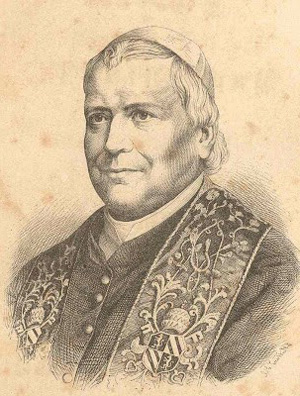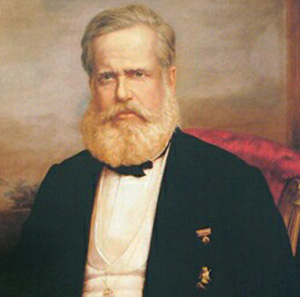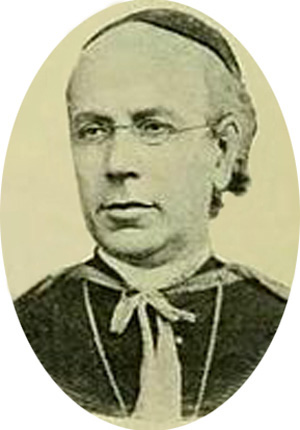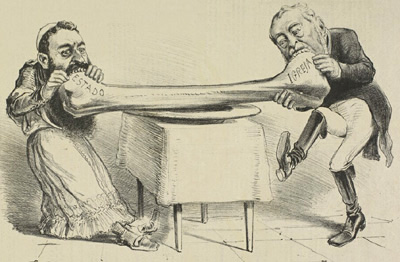Personalities
 |
 |
 |
 |
 |
 |
 |
Dom Vital – III
Pius IX Condemns, then Approves Dom Vital
While Dom Vital was imprisoned in the Ilha das Cobras, the worst spiritual trial of his life fell upon him.
 At that time, the Baron of Penedo, a leading Brazilian diplomat, was the Empire's ambassador to England. In reality, he was more the ambassador to the Rothschild family than to the English government, because the Rothschild family was the great creditor of Brazil.
At that time, the Baron of Penedo, a leading Brazilian diplomat, was the Empire's ambassador to England. In reality, he was more the ambassador to the Rothschild family than to the English government, because the Rothschild family was the great creditor of Brazil.
The Empire sent the Baron of Penedo to Rome as its envoy to advocate before the Pope for the condemnation of Dom Vital. Unfortunately, as a fruit of that negotiation, Pius IX sent a letter condemning him.
The papal letter arrived to the Apostolic Nuncio in Rio addressed to Dom Vital, but no one wanted to deliver it to the Prelate, who had become a national Catholic hero. In that awkward situation, the Bishop of Rio de Janeiro, Dom Pedro Maria de Lacerda, offered to deliver it personally to Dom Vital in his prison. This Prelate was a spineless man. When the Masonic newspapers of Rio published the lists of priests who belonged to Freemasonry and challenged Dom Lacerda to condemn them, he lacked the courage to do so.
A rule that has no exception is that the timorous man who fears the strong is courageous with those who are in a weak position. So, Dom Lacerda took up the mission of delivering the papal letter to Dom Vital.
Dom Vital received the letter, put it in his pocket, and said: “Thank you.” Surprised, Dom Lacerda asked, “But Your Excellency will not make the contents of the letter known?” Dom Vital replied, “No, the letter is addressed to me. Therefore, it is mine and I have no intention to publish its contents.”
 After two years, if my memory does not betray me, Dom Vital received a pardon from Emperor Pedro II. This measure originated from a request of his daughter Princess Isabel, who was very Catholic, and the Duke of Caxias, who had ascended to power as Prime Minister resting on the prestige he was enjoying from the successful wars on the South he had led. He believed it would be impossible for him to govern so long as Brazil was divided over the Religious Question: the fight of the Church against Freemasonry.
After two years, if my memory does not betray me, Dom Vital received a pardon from Emperor Pedro II. This measure originated from a request of his daughter Princess Isabel, who was very Catholic, and the Duke of Caxias, who had ascended to power as Prime Minister resting on the prestige he was enjoying from the successful wars on the South he had led. He believed it would be impossible for him to govern so long as Brazil was divided over the Religious Question: the fight of the Church against Freemasonry.
Let us not forget – and this is another important reason for Dom Pedro II to release the great Bishop – that the cabinet of the Baron of Rio Branco, the late Prime Minister, had fallen because of his measures against Dom Vital.
So, Dom Vital was absolved and brought before the Emperor to thank him. He was accompanied by Dom Macedo Costa, his companion in prison, also absolved. Dom Vital did not speak during the entire interview. He did not thank the Emperor because, first, he did not recognize that the Empire had power to condemn a Bishop; second, he knew that his condemnation was unjust and, therefore, it was not a favor to release him from prison but an act of the most elementary justice.
On the other hand, the joyful Dom Macedo lost no opportunity to thank Emperor Pedro II and flatter him as much as possible. It is interesting to note that when the Monarchy fell some years later, this same Dom Macedo took the side of the Republic and even wrote a pastoral letter praising it and deriding the throne he had previously flattered. This depicts the character of that Prelate.
 Dom Vital went to Recife and then to Europe to seek a cure for his state of health, which was rapidly declining due to the poisoning he had suffered in prison. Once in Europe, he went to Rome since his case should be judged by Pius IX.
Dom Vital went to Recife and then to Europe to seek a cure for his state of health, which was rapidly declining due to the poisoning he had suffered in prison. Once in Europe, he went to Rome since his case should be judged by Pius IX.
The Pope had been very ill informed about Dom Vital and received him coldly. A process was started to judge him in the Congregation of the Bishops and a commission of Cardinals was chosen to study the case. As Dom Vital visited the Cardinals to justify his actions, he encountered clear hostility. The commission was against him.
He tranquilly went to Lourdes to ask Our Lady to cure him. I know these details because one of my cousins – a priest – was the secretary of Dom Vital and travelled with him.
One morning in Lourdes, Dom Vital was half asleep in his hotel room when he thought he heard the voice of a boy inside the room telling him that he would win his case in Rome. Soon afterwards, in fact, he received a telegram telling him that the Cardinals had given a favorable report and the Congregation had found him innocent of any accusation.
I personally read the letter of a Capuchin Cardinal on that commission who affirmed that he could not explain how the favorable judgment was made since, until the eve of the sentence, he had been with the other members of the commission and all were against Dom Vital. Clearly, Divine Providence intervened and the Cardinals inexplicably changed their minds overnight. Probably that boy was an Angel announcing to Dom Vital that God had decided to intervene in the case in his favor.
On his return to Rome, he was again received by the Pope, who kissed his forehead. First, Pius IX had called him “testa calda,” a hothead. This time, however, he kissed his forehead to show that he realized that he had been ill informed and that Dom Vital was not a troublemaker. The Pope gave him a Missal and fully vindicated him. He went so far as to write a public document that was an indirect justification of Dom Vital.
He continued to travel throughout Europe seeking a cure for his weakening health. His illness was so grave that it caused him to spit up parts of his lungs. Dom Vital’s secretary told me that wherever he went he was followed by agents of Freemasonry.
 For example, after being in a city for two or three days, a man disguised as a beggar would appear to ask alms and inquire where he would travel next. Then, in the next city, the same man would appear with another disguise and more questions about his itinerary. Dom Vital himself remarked to his secretary that that man was an agent of the Secret Forces following them. He died when he was in Paris in the Monastery of the Capuchins.
For example, after being in a city for two or three days, a man disguised as a beggar would appear to ask alms and inquire where he would travel next. Then, in the next city, the same man would appear with another disguise and more questions about his itinerary. Dom Vital himself remarked to his secretary that that man was an agent of the Secret Forces following them. He died when he was in Paris in the Monastery of the Capuchins.
After he died, no causa mortis was given by the doctors. It is well known, however, that his death was caused by the poison the Freemasons put in the paint of his cell when he was in prison. Inhaling it caused the decay of his heath and finally his death.
In 1952, I was in Rome and went to converse with the Capuchin in charge of his cause of beatification. He told me: “You know, this cause cannot go forward because all the witnesses of that time have died. We cannot beatify a person when everyone who knew him is dead.” This is entirely false. It is nothing but an excuse.
Later, when I had returned to Brazil and was in Recife, I visited the Capuchins there and asked about Dom Vital’s cause of canonization. They told me that it had been extremely difficult to initiate the cause in Rome because this required the signature of the Archbishop of Olinda and Recife. Every time they asked for his approval, a different excuse was given to postpone it.
For example, once the Capuchins had presented the entire process to the Archbishop and, after it became clear the cause should be sent to Roma, he said, “Well then, we have to sign it.” He went to look for his pen and returned, telling the Capuchins, “You see, my pen is not working. I cannot sign it.” They replied, “Your Excellency, here is another pen. You may sign with this one.” He answered, “Each of us has his own peculiar customs. I have this one: I only sign documents with my own pen.” And he did not sign.
At present the process of beatification of Dom Vital is at a standstill. It would be a most glorious canonization since he was a martyr and gave his life for the Church. He fought as a hero against one of the most perfidious enemies of the Church, Freemasonry.
In the Reign of Mary we should promote his canonization. The feast day of Saint Dom Vital Maria Gonçalves de Oliveira would be a glorious one indeed.


Badly informed, Pius IX sent
a letter condemning Dom Vital
The Empire sent the Baron of Penedo to Rome as its envoy to advocate before the Pope for the condemnation of Dom Vital. Unfortunately, as a fruit of that negotiation, Pius IX sent a letter condemning him.
The papal letter arrived to the Apostolic Nuncio in Rio addressed to Dom Vital, but no one wanted to deliver it to the Prelate, who had become a national Catholic hero. In that awkward situation, the Bishop of Rio de Janeiro, Dom Pedro Maria de Lacerda, offered to deliver it personally to Dom Vital in his prison. This Prelate was a spineless man. When the Masonic newspapers of Rio published the lists of priests who belonged to Freemasonry and challenged Dom Lacerda to condemn them, he lacked the courage to do so.
A rule that has no exception is that the timorous man who fears the strong is courageous with those who are in a weak position. So, Dom Lacerda took up the mission of delivering the papal letter to Dom Vital.
Dom Vital received the letter, put it in his pocket, and said: “Thank you.” Surprised, Dom Lacerda asked, “But Your Excellency will not make the contents of the letter known?” Dom Vital replied, “No, the letter is addressed to me. Therefore, it is mine and I have no intention to publish its contents.”

Emperor Pedro II found it more prudent for his government to release Dom Vital from prison
Let us not forget – and this is another important reason for Dom Pedro II to release the great Bishop – that the cabinet of the Baron of Rio Branco, the late Prime Minister, had fallen because of his measures against Dom Vital.
So, Dom Vital was absolved and brought before the Emperor to thank him. He was accompanied by Dom Macedo Costa, his companion in prison, also absolved. Dom Vital did not speak during the entire interview. He did not thank the Emperor because, first, he did not recognize that the Empire had power to condemn a Bishop; second, he knew that his condemnation was unjust and, therefore, it was not a favor to release him from prison but an act of the most elementary justice.
On the other hand, the joyful Dom Macedo lost no opportunity to thank Emperor Pedro II and flatter him as much as possible. It is interesting to note that when the Monarchy fell some years later, this same Dom Macedo took the side of the Republic and even wrote a pastoral letter praising it and deriding the throne he had previously flattered. This depicts the character of that Prelate.

Dom Antonio de Macedo Costa
The Pope had been very ill informed about Dom Vital and received him coldly. A process was started to judge him in the Congregation of the Bishops and a commission of Cardinals was chosen to study the case. As Dom Vital visited the Cardinals to justify his actions, he encountered clear hostility. The commission was against him.
He tranquilly went to Lourdes to ask Our Lady to cure him. I know these details because one of my cousins – a priest – was the secretary of Dom Vital and travelled with him.
One morning in Lourdes, Dom Vital was half asleep in his hotel room when he thought he heard the voice of a boy inside the room telling him that he would win his case in Rome. Soon afterwards, in fact, he received a telegram telling him that the Cardinals had given a favorable report and the Congregation had found him innocent of any accusation.
I personally read the letter of a Capuchin Cardinal on that commission who affirmed that he could not explain how the favorable judgment was made since, until the eve of the sentence, he had been with the other members of the commission and all were against Dom Vital. Clearly, Divine Providence intervened and the Cardinals inexplicably changed their minds overnight. Probably that boy was an Angel announcing to Dom Vital that God had decided to intervene in the case in his favor.
On his return to Rome, he was again received by the Pope, who kissed his forehead. First, Pius IX had called him “testa calda,” a hothead. This time, however, he kissed his forehead to show that he realized that he had been ill informed and that Dom Vital was not a troublemaker. The Pope gave him a Missal and fully vindicated him. He went so far as to write a public document that was an indirect justification of Dom Vital.
He continued to travel throughout Europe seeking a cure for his weakening health. His illness was so grave that it caused him to spit up parts of his lungs. Dom Vital’s secretary told me that wherever he went he was followed by agents of Freemasonry.

Dom Vital and the Duke of Caxias, the two poles of the Religious Question in Brazil - a hard bone to gnaw
After he died, no causa mortis was given by the doctors. It is well known, however, that his death was caused by the poison the Freemasons put in the paint of his cell when he was in prison. Inhaling it caused the decay of his heath and finally his death.
In 1952, I was in Rome and went to converse with the Capuchin in charge of his cause of beatification. He told me: “You know, this cause cannot go forward because all the witnesses of that time have died. We cannot beatify a person when everyone who knew him is dead.” This is entirely false. It is nothing but an excuse.
Later, when I had returned to Brazil and was in Recife, I visited the Capuchins there and asked about Dom Vital’s cause of canonization. They told me that it had been extremely difficult to initiate the cause in Rome because this required the signature of the Archbishop of Olinda and Recife. Every time they asked for his approval, a different excuse was given to postpone it.
For example, once the Capuchins had presented the entire process to the Archbishop and, after it became clear the cause should be sent to Roma, he said, “Well then, we have to sign it.” He went to look for his pen and returned, telling the Capuchins, “You see, my pen is not working. I cannot sign it.” They replied, “Your Excellency, here is another pen. You may sign with this one.” He answered, “Each of us has his own peculiar customs. I have this one: I only sign documents with my own pen.” And he did not sign.
At present the process of beatification of Dom Vital is at a standstill. It would be a most glorious canonization since he was a martyr and gave his life for the Church. He fought as a hero against one of the most perfidious enemies of the Church, Freemasonry.
In the Reign of Mary we should promote his canonization. The feast day of Saint Dom Vital Maria Gonçalves de Oliveira would be a glorious one indeed.

Posted July 22, 2015
______________________
______________________











